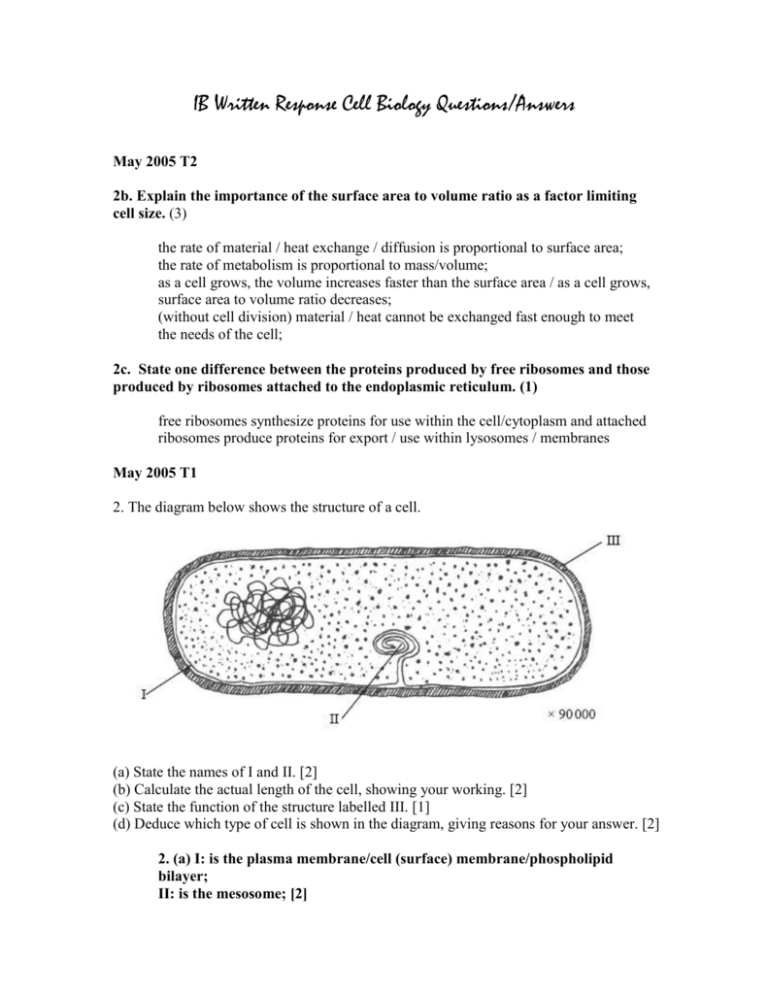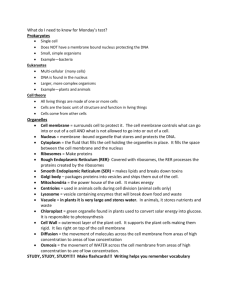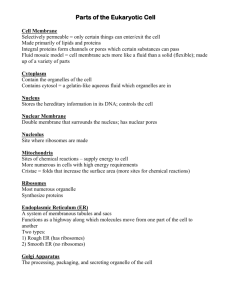IB Written Response Cell Biology Questions
advertisement

IB Written Response Cell Biology Questions/Answers May 2005 T2 2b. Explain the importance of the surface area to volume ratio as a factor limiting cell size. (3) the rate of material / heat exchange / diffusion is proportional to surface area; the rate of metabolism is proportional to mass/volume; as a cell grows, the volume increases faster than the surface area / as a cell grows, surface area to volume ratio decreases; (without cell division) material / heat cannot be exchanged fast enough to meet the needs of the cell; 2c. State one difference between the proteins produced by free ribosomes and those produced by ribosomes attached to the endoplasmic reticulum. (1) free ribosomes synthesize proteins for use within the cell/cytoplasm and attached ribosomes produce proteins for export / use within lysosomes / membranes May 2005 T1 2. The diagram below shows the structure of a cell. (a) State the names of I and II. [2] (b) Calculate the actual length of the cell, showing your working. [2] (c) State the function of the structure labelled III. [1] (d) Deduce which type of cell is shown in the diagram, giving reasons for your answer. [2] 2. (a) I: is the plasma membrane/cell (surface) membrane/phospholipid bilayer; II: is the mesosome; [2] (b) size of drawing divided by magnification / figures using this equation; (units not required) Award [1] for working even if length measurement is incorrect. 1.41 (! 0.02) μm; (units required) [2] Accept answers given in m, cm, mm and nm. (c) protection / support / maintains shape / prevents bursting [1] (d) bacterium/bacteria/prokaryote; reason: [1 max] as no nuclear membrane / no nucleus; as no mitochondria / membrane bound organelles; as mesosomes / small size / circular DNA; (Do not accept naked DNA or no histone.) [2 max] Reject reasons if cell type is incorrectly identified. May 2004 T2 6. (a) Discuss possible exceptions to the cell theory. [4] (a) skeletal muscle fibres are larger / have many nuclei / are not typical cells; fungal hyphae are (sometimes) not divided up into individual cells; unicellular organisms can be considered acellular; because they are larger than a typical cell / carry out all life functions; some tissues / organs contain large amounts of extracellular material; e.g. vitreous humour of eye / mineral deposits in bone / xylem in trees / other example; statement of cell theory / all living things/most tissues are composed entirely of true cells; [4 max] May 2004 T1 2. (a) Explain how the surface area to volume ratio influences cell sizes. [3] (b) State one function for each of the following organelles. [3] (i) Ribosomes ..................................................................... (ii) Rough endoplasmic reticulum ..................................................................... (iii) Golgi apparatus ..................................................................... (c) Compare prokaryotic and eukaryotic cells in regards to three different features. [3] 2. (a) small cells have larger ratio (than larger cells) / ratio decreases as size increases; surface area/membrane must be large enough to absorb nutrients/oxygen/substances needed; surface area/membrane must be large enough to excrete/pass out waste products; need for materials is determined by (cell) volume; cell size is limited (by SA vol / ratio) / cells divide when they reach a certain size; reference to diffusion across/through membrane/surface area; [3 max] (b) Award [1 max] for each organelle. Mark first answer only. (i) translation / produces polypeptides / proteins / protein synthesis; (ii) support of ribosomes / site of protein synthesis / synthesis of proteins for secretion / folding of polypeptides; (iii) produces glycoproteins / processing of proteins / forms lysosomes / formation of vesicles (for exocytosis); [3 max] (c) Award [1] for each of the following pairs. Mark first answer only in boxes 1, 2 and 3. prokaryotic cells eukaryotic cells nucleoid / no nucleus / nuclear membrane vs. nucleus / nuclear membrane; naked DNA / no histones vs. DNA associated with protein / histone; no mitochondria vs. mitochondria present; no Golgi / no ER vs. Golgi / ER present; circular DNA vs. linear DNA; no/very few membrane-bound organelles vs. membrane-bound organelles; ribosomes smaller / 70S vs. ribosomes larger / 80S; no mitosis / meiosis vs. mitosis / meiosis; flagella lack internal microtubules vs. flagella have microtubules (9+2); [3 max] Allow [1] only for a similarity. May 2003 4. (a) Draw a diagram of the ultrastructure of an animal cell as seen in an electron micrograph. [6] 4. (a) Award [1] for each of the following structures clearly drawn and labelled correctly. Award marks for labelled eukaryotic structures, then deduct [1] per labelled prokaryotic structure shown e.g. mesosome, cell wall. nuclear membrane / nucleus (with nuclear membrane shown double with pores); ribosomes (free or attached to ER); endoplasmic reticulum / ER; plasma / cell membrane (reject if shown as double line); mitochondria (shown with inner and outer membrane); Golgi (apparatus); lysosomes; Nov 2003 7. (c) Explain the role of vesicles in transportation of materials within cells. (c) Marks can be achieved by means of a suitable annotated diagrams. vesicles are membrane bound packages/droplets; formed by pinching off/budding off a piece from a membrane; can carry proteins; rough ER synthesizes proteins; proteins enter/accumulate inside the ER; transported to Golgi apparatus for processing; targeted to/transported to specific cellular organelles; fuse with membrane of organelle so contents of vesicle join the organelle; transported to the plasma membrane; fuses with plasma membrane releases/secretes contents; exocytosis; [8 max] May 2002 6. (a) Draw the structure of a mitochondrion as seen in an electron micrograph. [5] 6. (a) Award [1] for each of the following structures clearly drawn and labelled correctly. outer membrane; intermembrane space / outer compartment; inner membrane; matrix; cristae; ribosome; naked / circular DNA; ATP synthase; Do not accept plasma membrane. Nov 2000 4. (a) Draw a diagram to show the organelles which are found in the cytoplasm of plant cells. [6] 4. (a) (Award [1 mark] for each of the following structures accurately drawn and labelled.) rough endoplasmic reticulum; (free) ribosomes; Golgi apparatus; mitochondrion; chloroplast; vacuole; nucleus; lysosome and smooth endoplasmic reticulum; May 1999 4. (c) Discuss whether the light microscope or the electron microscope is more useful for studying cells, tissues and organs. [5] (Award 1 mark for any of the below; up to a maximum of 5 marks) Advantages of light microscope Colours of material from tissues/organ can be seen; Living material can be studied/less damage to specimen; Cell activities/movement can be studied Larger field of view Advantages of electron microscope Greater resolution Smaller structures can be seen/greater magnification; (Award up to 2 marks for the following overall assessment) Electron microscope better for cells/small structures; But light microscope better for organs;









